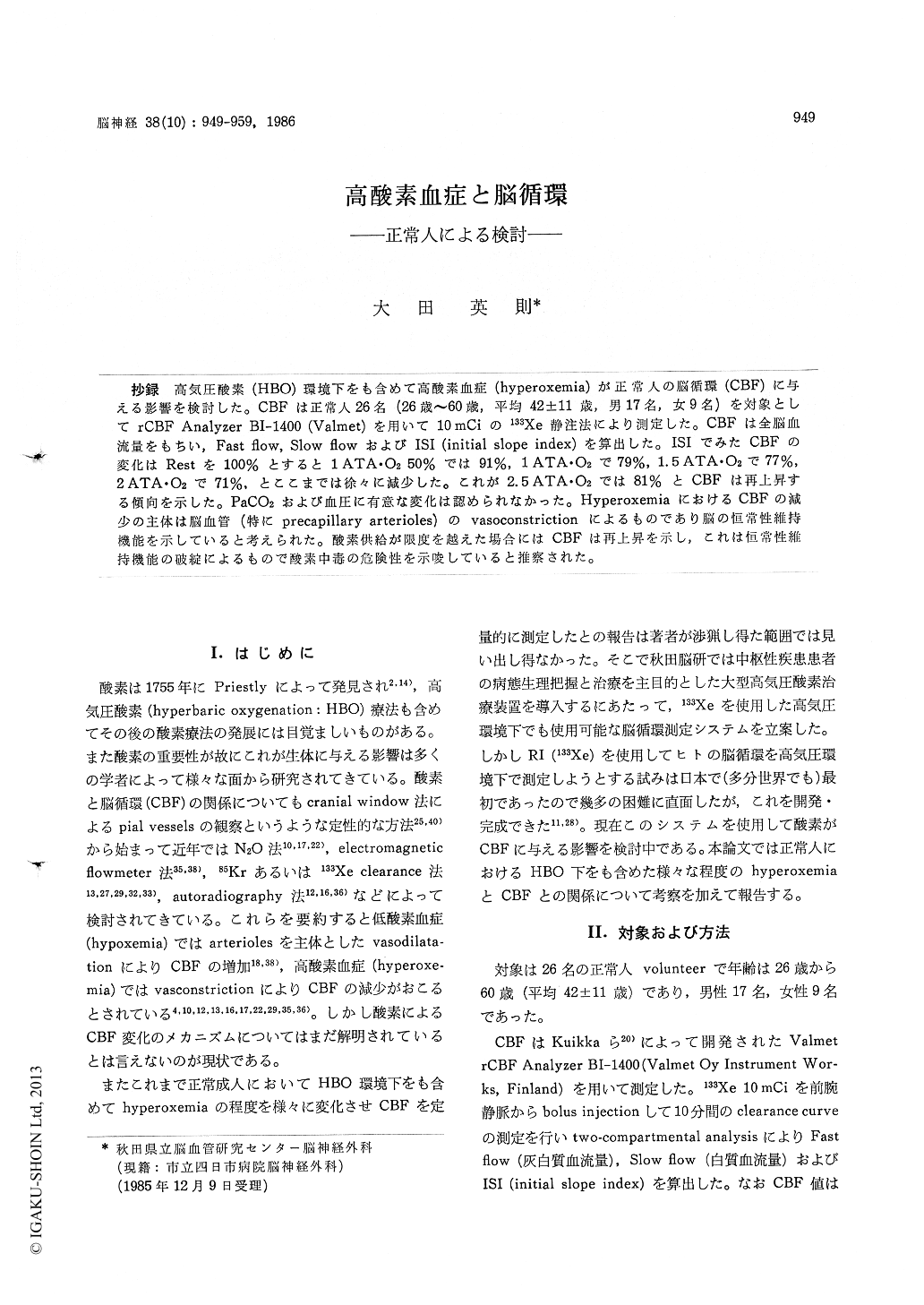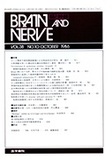Japanese
English
- 有料閲覧
- Abstract 文献概要
- 1ページ目 Look Inside
抄録 高気圧酸素(HBO)環境下をも含めて高酸素血症(hyperoxemia)が正常人の脳循環(CBF)に与える影響を検討した。CBFは正常人26名(26歳〜60歳,平均42±11歳,男17名,女9名)を対象としてrCBF Analyzer Bl−1400(Valmet)を用いて10mCiの133Xe静注法により測定した。CBFは全脳血流量をもちい,Fast flow, Slow flowおよびISI (initial slope index)を算出した。ISIでみたCBFの変化はRestを100%とすると1ATA・O2 50%では91%,1ATA・O2で79%,1.5ATA・O2で77%,2ATA・O2で71%,とここまでは徐々に減少した。これが2.5ATA・O2では81%とCBFは再上昇する傾向を示した。PaCO2および血圧に有意な変化は認められなかった。HyperoxemiaにおけるCBFの減少の主体は脳血管(特にprecapillary arterioles)のvasoconstrictionによるものであり脳の恒常性維持機能を示していると考えられた。酸素供給が限度を越えた場合にはCBFは再上昇を示し,これは恒常性維持機能の破綻によるもので酸素中毒の危険性を示唆していると推察された。
The aim of this study was to evaluate the effect of various degrees of hyperoxemia on cerebral blood flow (CBF), including the hyperbaric oxy-genation (HBO) environment. Study subjects were 26 healthy volunteers (17 males and 9 females) from 26 to 60 (average : 42±11) years old. CBF measurements were done by 10 mCi 133Xe intra-venous injection method using rCBF analyzer BI-1400 (Valmet). Two-compartmental analysis was used for the calculation of Fast Flow, Slow Flow and initial slope index (ISI). The three CBF study series included : a) Rest (before HBO 1 ATA・ air)-1 ATA・O2-2 ATA・O2 series in 8 cases ; b) Rest-1 ATA・O2 50% N2 50%-1.5 ATA・O2 series in 10 cases ; and c) Rest-2.5 ATA・O2-after HBO (1 ATA・air) series in 8 cases. CBF measurements commenced 5 to 10 minutes after fixing a mask for oxygen inhalation. Arterial blood gas analyses using IL-813 (IL) and blood pressure measurements were done immediately after CBF measurements. CBF changes evaluated by ISI, estimating rest-ing flow as 100% (PaO2: 93±8 mmHg), were 91% at 1 ATA・O2 50% (PaO2: 201±50 mmHg), 79% at 1 ATA・ O2 (PaO2: 432±44 mmHg), 77% at 1. 5 ATA・O2 (PaO2: 693±79 mmHg) and 71% at 2 ATA・O2 (PaO2: 838±95 mmHg). CBF gradually decreased to the level shown for 2 ATA・O2, but CBF showed a tendency to increase somewhat at 2.5 ATA・O2 (81%, PaO2 : 1103±111 mmHg). CBF decreases were statistically significant at 1 ATA・ O2, 1.5 ATA・O2, 2 ATA・O2 and also 2.5 ATA・O2 compared with Rest (P<0. 05). Arterial blood gas analyses clearly showed the stepwise increase in PaO2 to the level of 2. 5ATA・O2 (P<0. 01). Chan-ges in PaCO2 and blood pressure were slight and not significant statistically in each series.
Since the data showed no significant change in the PaCO2 level in each series, it was concluded that the CBF decrease was due to vasoconstriction caused by the elevated PaO2. The mechanism of cerebral vasoconstriction caused by hyperoxemia is not yet clearly understood, but the direct vasocon-strictive effect of oxygen, neurogenic control and the metabolic effect of an elevated cerebral tissue oxygen level may contribute to the CBF decrease.
CBF decrease during elevated PaO2 may be a protective physiological response to maintain nor-mal brain metabolism and function against the excessive oxygen supply. Disturbance of this regu-latory mechanism may result in oxygen poi-soning of the central nervous system. The author's study revealed an increase in CBF at the level of 2.5 ATA・O2, following gradual decreases in CBF to the level of 2 ATA?O22. Nevertheless, a decrease in CBF was shown in comparison with the resting state (P<0.05). This may suggest a disturbance of the regulatory mechanism of homeostasis due tothe excessive oxygen supply and imply the impend-ing danger of oxygen poisoning.
The author proposes to term the constriction of cerebral vessels and the CBF decrease caused by hyperoxemia, "oxygen response". This response may be one of the regulatory mechanisms of CBF like autoregulaton, neurogenic control or CO2 re-sponse. CBF measurement with the inhalation of pure oxygen at atmospheric pressure is a safe and valuable clinical test for the evaluation of cerebro-vascular response.

Copyright © 1986, Igaku-Shoin Ltd. All rights reserved.


